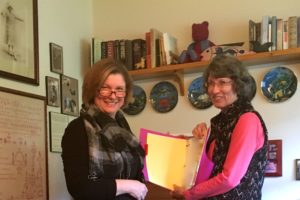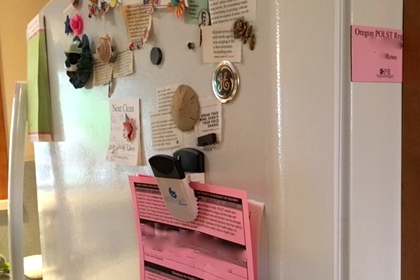By Lisa Vigil Schattinger, MSN, RN
December 8, 2016 and updated April 15, 2019.
They say that it’s a good idea to introduce the topic of end-of-life wishes around the table at Thanksgiving. My mother and I didn’t wait until then.
The day before Thanksgiving, we were in the small room that serves as her office. Vibrant reminders of friends and family who’ve died surrounded us. There were lots of mementos from her trips abroad as well as things that she loves for her own special reasons. It’s a distilled sample of all that makes my mother who she is.

We were there for a couple of reasons. One was because we had been talking to a lot of people about filling out their advance directives since starting Ohio End of Life Options, a 501(c)3 non-profit organization. We had realized that we needed to be practicing what we preach and have all of our own paperwork in order. Since my mother lives in Oregon and I live in Ohio, we need to be organized, transparent and continue to communicate openly as we both age.
The other reason was for me to be able to honor my mother, Janet Rowe, by learning about her end-of-life wishes. Mom is an incredibly caring person. She is a retired nurse and has been a Hospice volunteer for over twenty years. Since my stepfather Jack’s death, she has also become very involved with End of Life Choices Oregon. It’s an organization that facilitates the steps of the Death with Dignity Act for patients and doctors who choose to participate.
Between the two of us, we have been Healthcare Proxy for three people who’ve died between the ages 96 – 104. I’m very thankful that we were able to support each other as we acted on behalf of loved ones as they aged and then died, died unexpectedly or died from a long, drawn out disease process. We’ve come to understand just how unique each person’s aging experience is with regard to health, financial resources and family dynamics.
We were both there 4 1/2 years ago when my mother’s husband, Jack, died peacefully after taking the medication that had been made available to him through Oregon’s Death with Dignity Act. His was such a peaceful death, compared to all that we’d seen, that it brought my mother and me even closer together. And it compelled us to start talking to people to share our experiences.
Mom has a lot more know-how than I, but my experience as my grandmother’s long-distance caregiver was difficult. It was filled with emergencies and tough decisions. I felt incredibly fortunate to be able to talk to my mother through all of it.
Largely because of our experiences, we both feel – in every part of our beings — that in order to live well, we need to be prepared for aging and dying well.
So there we were. Mom showed me where she keeps what I call her Folder of Wishes, a bright pink folder with lists of important information in case a sudden illness or accident leaves her incapacitated.
Since she is a young, active and healthy 73-year-old, my brother and I are not concerned about needing this information any time soon. But that is exactly the point. Who knows when a health event or accident will occur?
We don’t want to be caught unprepared and uninformed of her wishes.
The folder includes her Oregon Physicians Orders for Life Sustaining Treatment (POLST) form which is considered her portable DNR orders. “A POLST form assures patients that health care professionals will provide only the treatments that patients themselves wish to receive, and not the treatments they wish to avoid.” POLST is meant for people with serious illnesses or frailty to review and fill out with their physicians. My mother is not seriously ill or frail but she lives in a retirement community that encourages everyone to fill one out and display it prominently. It helps people understand what decisions may need to be made as they age.

During my own planning, I found out that Ohio does not have a statewide approved form like this. Ohio has a DNR Form on which one may choose “Do-Not-Resuscitate Comfort Care (DNRCC) and Do-Not-Resuscitate Comfort Care -Arrest (DNRCC-Arrest) orders [which] allow individuals to make their choices pertaining to CPR known to emergency services personnel, heath care facilities, and healthcare providers.”
Mom’s folder also has a copy of her Advance Directive which is comprised of her Living Will (what decisions should be made about resuscitation or artificial breathing if she is incapacitated and unable to make decisions in the hospital setting) and her Heath Care Proxy/ Durable Power of Attorney for Health Care designation (who is appointed to make sure these wishes are respected). In Ohio, these documents do not need to be notarized.
The folder also includes her funeral arrangements and specifics about cremation vs. burial, any memorial or funeral plans and details about how she would like to be remembered, including a draft obituary. Her funeral plans are already made and paid for so she knows that her wishes will be carried out.
My brother and I are already co-signers on some of her bank accounts and have met her financial planner. Mom also introduced me to the manager at her bank branch so that she would know who I am if I ever need to take over banking duties.
We are lucky that we all trust each other and communicate well. We know plenty of families who struggle with this for various reasons. We share the goal of taking care of Mom according to her wishes if that care is needed. It’s wonderful to be able to talk openly about her thoughts and concerns as she ages.
Since she lives in a Continuing Care Retirement Community (CCRC), she and my stepfather had already made the commitment to living in that type of environment before he died. Where she lives, as people age, they move up the hill because the independent town homes (where she now lives) are near the bottom of the hill and the skilled nursing facility (where she may or may not spend her final days) is on the top of the hill.
I had assumed that someday I would move her to be close to me in Ohio if she needs around the clock nursing care. However, she said very clearly, “I don’t mind going to the nursing center here if necessary. They are well-trained and respectful of the residents, so I’d be okay with that.” Now, that doesn’t mean that seeing that happen will be easy. I’ll be traveling a lot should that time come.
So that’s the plan for now. But I found with my grandmother, who also lived in a CCRC, that knowing exactly when these moves to different levels of care should happen can also be complicated. By living in a community like this, one may assume that his or her care while aging will be a seamless process. However, I found that each transition, from independent living to assisted living and then to the nursing care center, required a lot of coordination between the various on-campus facilities and our family. Being familiar with the personnel, such as the social workers and administrators, at the CCRC is helpful when advice or help is needed. Keep in mind that the people in these positions may change often so it’s a good idea to have quarterly updates.
It was a great honor being the primary decision maker for my grandmother. It is both daunting and a privilege to think of doing this for my mother.
I do not know if she will ever need the same types of decisions made that my grandmother did. But knowing my mother well, already knowing about her finances, and talking about her wishes for aging and dying well, make me more confident that I will be carrying out her thoughts and plans to the best of my ability.
Our experiences have made my mother and me very pragmatic. I realize that not everyone is the same way. But any time that I’ve started a conversation with a loved one by saying, “I’d like to understand what you’d want in this situation…” it always leads to a profound discussion.
Please, make the effort to talk with your loved ones about their plans as well as the details involved for aging and dying well. Consider putting together your own Folder of Wishes. It is also important to understand the types of legal documents that need to be put in place so that ones’ wishes are respected. And remember, these wishes change over time so please plan to revisit them.
For more information go to CaringInfo.org.
